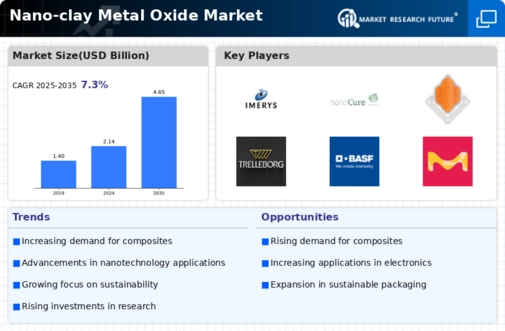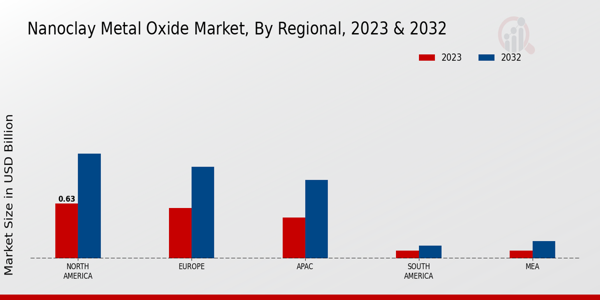Market Growth Projections
The Global Nano-clay Metal Oxide Market Industry is projected to experience robust growth in the coming years, with estimates indicating a market size of 2.14 USD Billion in 2024 and a potential increase to 4.65 USD Billion by 2035. This growth trajectory suggests a compound annual growth rate (CAGR) of 7.3% from 2025 to 2035, reflecting the increasing adoption of nano-clay metal oxides across diverse industries. The anticipated expansion is driven by factors such as technological advancements, rising demand for lightweight materials, and the growing emphasis on sustainability. These projections underscore the market's potential and the evolving landscape of nano-clay metal oxide applications.
Advancements in Nanotechnology
Technological advancements in nanotechnology are significantly influencing the Global Nano-clay Metal Oxide Market Industry. Innovations in synthesis and processing techniques have led to enhanced performance characteristics of nano-clay metal oxides, making them more appealing for various applications. For example, improved dispersion methods have resulted in better compatibility with polymers, thereby expanding their use in coatings and packaging. This evolution is expected to drive market growth, with projections indicating a rise to 4.65 USD Billion by 2035. The continuous development of nanotechnology is likely to create new opportunities and applications, further solidifying the market's position.
Emerging Applications in Healthcare
Emerging applications of nano-clay metal oxides in the healthcare sector are becoming a notable driver for the Global Nano-clay Metal Oxide Market Industry. These materials are being explored for their potential use in drug delivery systems, diagnostics, and medical imaging. Their biocompatibility and ability to enhance the efficacy of therapeutic agents make them attractive for pharmaceutical applications. As research progresses, the integration of nano-clay metal oxides into healthcare solutions is likely to expand, creating new market opportunities. This trend indicates a diversification of applications, further solidifying the market's relevance in various sectors.
Increasing Environmental Regulations
The Global Nano-clay Metal Oxide Market Industry is also being propelled by increasing environmental regulations aimed at reducing pollution and waste. Governments worldwide are implementing stricter guidelines that encourage the use of eco-friendly materials in manufacturing processes. Nano-clay metal oxides, known for their non-toxic nature and recyclability, align well with these regulatory frameworks. As industries adapt to comply with these regulations, the demand for sustainable materials is expected to rise. This shift not only enhances the market's growth potential but also contributes to a more sustainable future, as companies seek to minimize their environmental footprint.
Rising Demand for Lightweight Materials
The Global Nano-clay Metal Oxide Market Industry is experiencing a surge in demand for lightweight materials across various sectors, including automotive and aerospace. The incorporation of nano-clay metal oxides enhances the mechanical properties of composites, making them more durable and lightweight. This trend is particularly evident as manufacturers seek to improve fuel efficiency and reduce emissions. For instance, the automotive sector is increasingly adopting these materials to meet stringent regulatory standards. As a result, the market is projected to reach 2.14 USD Billion in 2024, reflecting a growing recognition of the benefits of lightweight solutions.
Growth in Electronics and Electrical Applications
The Global Nano-clay Metal Oxide Market Industry is witnessing substantial growth driven by the increasing use of nano-clay metal oxides in electronics and electrical applications. These materials exhibit unique electrical properties that make them suitable for various electronic components, including capacitors and sensors. As the demand for miniaturization and enhanced performance in electronic devices continues to rise, manufacturers are increasingly incorporating nano-clay metal oxides into their products. This trend is expected to contribute to a compound annual growth rate (CAGR) of 7.3% from 2025 to 2035, highlighting the potential for sustained growth in this segment.








